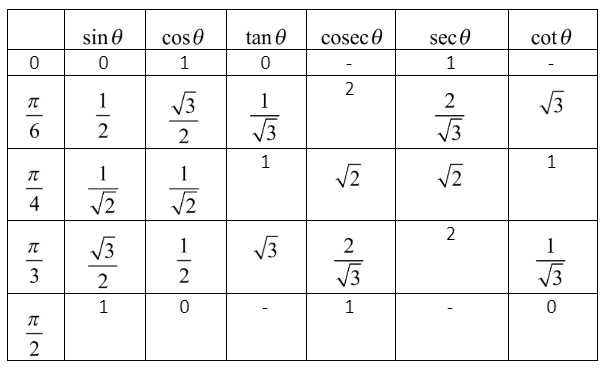
For the principal value, evaluate the following
Answer
516.9k+ views
Hint:First of all, use
Complete step-by-step answer:
In this question, we have to find the principal value of
First of all, let us consider the expression given in the question,
We know that,
Now, let us draw the table for trigonometric ratios of general angles.

From the above table, we can see that,
So, by substituting the value of
We know that,
Now, from the trigonometric table, we can see that,
Now we know that the range of principal value of
From the table of general trigonometric ratios, we get,
Now by substituting the value of
Hence, we get the value of
Note: In this question, students must take care that the value of the angle must lie in the range of
Complete step-by-step answer:
In this question, we have to find the principal value of
First of all, let us consider the expression given in the question,
We know that,
Now, let us draw the table for trigonometric ratios of general angles.

From the above table, we can see that,
So, by substituting the value of
We know that,
Now, from the trigonometric table, we can see that,
Now we know that the range of principal value of
From the table of general trigonometric ratios, we get,
Now by substituting the value of
Hence, we get the value of
Note: In this question, students must take care that the value of the angle must lie in the range of
Latest Vedantu courses for you
Grade 8 | CBSE | SCHOOL | English
Vedantu 8 CBSE Pro Course - (2025-26)
School Full course for CBSE students
₹45,300 per year
Recently Updated Pages
Master Class 4 Maths: Engaging Questions & Answers for Success

Master Class 4 English: Engaging Questions & Answers for Success

Master Class 4 Science: Engaging Questions & Answers for Success

Class 4 Question and Answer - Your Ultimate Solutions Guide

Master Class 11 Economics: Engaging Questions & Answers for Success

Master Class 11 Business Studies: Engaging Questions & Answers for Success

Trending doubts
Give 10 examples of unisexual and bisexual flowers

Draw a labelled sketch of the human eye class 12 physics CBSE

Differentiate between homogeneous and heterogeneous class 12 chemistry CBSE

a Tabulate the differences in the characteristics of class 12 chemistry CBSE

Why is the cell called the structural and functional class 12 biology CBSE

Differentiate between insitu conservation and exsitu class 12 biology CBSE




